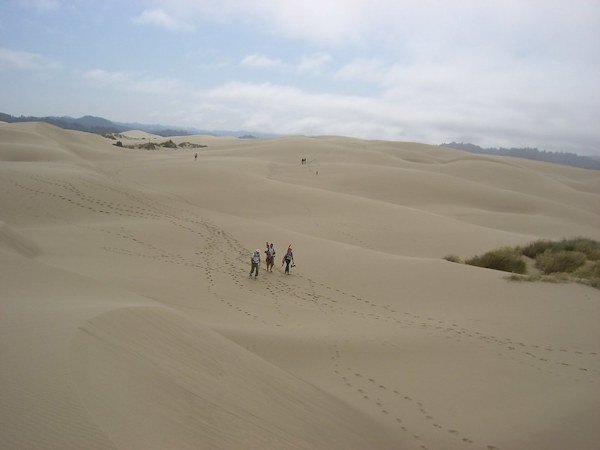At OSU, shifting sands were a prime research focus long before the ‘Dune’ movies took center stage

CORVALLIS, Ore. (KTVZ) – Three years after the release of “Dune,” a film adaptation of Frank Herbert’s epic 1965 sci-fi novel, “Dune: Part Two” is reigniting the public’s fascination with sandy environs and humanity’s efforts to reshape them.
But long before the second movie came out earlier this month and ascended to the height of cinematic popularity, researchers at Oregon State University were taking deep dives into the world of dunes, especially the Oregon coastal dunes that served as inspiration for Herbert.
“I just watched ‘Dune: Part Two’ and I think one interesting similarity between the movie and what happens in real life is how the shifting sand of the dunes can’t be entirely controlled,” said Meagan Wengrove, assistant professor of civil and construction engineering in the OSU College of Engineering. “In the movie high winds wipe out built infrastructure, and in regions of large sand supply in Oregon, high winds bury homes to their roofs on occasion.”
Wengrove, who last year published a paper showing that newly planted vegetation can accelerate erosion during extreme storms, and OSU colleagues Sally Hacker and Peter Ruggiero are working with the Oregon departments of Parks and Recreation and Land Conservation and Development to create guidebooks for coastal dune management based on the best available science.
“These guidebooks include information from 20 years of monitoring by Sally and Peter and also monitoring we have done recently to better quantify how human practices nowadays influence dune morphologic change,” Wengrove said.
Wengrove’s research group is also working with Hacker and Ruggiero on projects designed to predict the evolution of dune morphology – shape and structure – based on different levels of sand trapping as it relates to beachgrass species. In addition, Wengrove is starting a study that aims to quantify how a Cascadia tsunami could change the dunes and how much the dunes matter when it comes to inundation from a tsunami.
Hacker, a professor of integrative biology in the College of Science, notes that coastal ecosystems, particularly beaches and dunes, “are gaining recognition as important arbiters of the effects of tsunamis, extreme storms and sea level rise on coastal communities.”
Hacker’s work focuses on the biophysical interactions between waves, wind, sand and coastal vegetation. Her goal is a better understanding of the processes that control large-scale variation in dune morphology and its role in coastal protection, recreation, native species conservation and carbon storage.
“In the Pacific Northwest, we explore how non-native coastal plants invade and modify their environment,” she said. “Most recently, we have focused on beachgrass invasions and their effects on dune ecosystem structure, function and services.”
Hacker notes that a century ago, two non-native beachgrass species – Ammophila arenaria and Ammophila breviligulata – were intentionally planted on the Pacific coast to stabilize what was then an open, shifting-sand environment. The result, she says, was a landscape-level transformation of dune ecosystems with wide-ranging consequences.
“We have studied this system from a variety of perspectives including the relationship of the two beachgrass species to dune building, carbon storage, native plant and animal species and hybridization of the two non-native grass species,” she said.
Ruggiero, a professor in the College of Earth, Ocean, and Atmospheric Sciences, has more than two decades of experience assessing the impacts of storms and climate change on beaches, dunes, coastal ecosystems, and towns and cities.
He’s also the principal investigator of the Cascadia Coastlines and Peoples Hazards Research Hub, which focuses on increasing resilience among coastal communities in the Northwest and supports some of this dune research.
“My primary research interests are coastal geomorphology and coastal hazards,” Ruggiero said. “Right now my research group is developing probabilistic approaches for assessing vulnerability to coastal hazards in light of a changing and variable climate. Our dunes work involves both monitoring and stochastic modeling, with the eventual goal of predicting long-term coastal dune evolution with and without human interventions.”